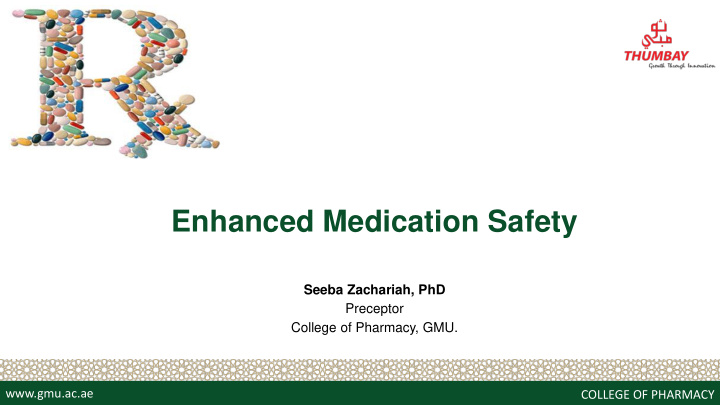



Enhanced Medication Safety Seeba Zachariah, PhD Preceptor College of Pharmacy, GMU. www.gmu.ac.ae COLLEGE OF PHARMACY
Learning Objectives Upon completion of this session, participants will be able to; • Recognize importance of medication safety. • Identify medication errors in different setting. • Discuss how to enhance medication safety. Disclaimer: This presentation is for academic purpose only.
Medication errors (MEs) Medication errors (MEs) are defined as any mistake at any stage of the medication use process • selection and procurement, • storage, • ordering and transcribing, • preparing and dispensing, • administration, or • monitoring.
Medication errors Correlation with harm and preventability
Medication errors Correlation with harm and preventability
Examples • Patient was switched to different insulin product without dose adjustment written on the prescription and experienced hypoglycemia. • Patient well controlled on antiepileptic medicines failed to get repeat supply and was hospitalized with partial seizures. • Infant was administered overdose of antipyretic solution for infusion due to a confusion of ‘mg’ with ‘ml’.
Examples…. • Patient was dispensed the wrong product due to confusion of packs. • A 3-month-old baby was inadvertently given an ibuprofen syrup quantity measured for a 3-year-old child. • A father administered one paracetamol suppository to his child without knowing that the child already had received the suppository 10 minutes before.
Why Medication Safety is Important • ADEs are a serious public health problem. • more than 1 million emergency department visits. • 280,000 hospitalizations each year. • $3.5 billion is spent on medical costs of ADEs annually. • more than 40% of costs related to ambulatory ADEs are preventable .
Most common causes are anticoagulants, antibiotics, Hypoglycemic drugs, and opioid analgesics. • children and adolescents: Antibiotics • adults : Antibiotics • older adults: Anticoagulants and Hypoglycemic drugs.
Geriatrics • Twice as likely as others to come to ED. • Nearly seven times more likely to be hospitalized after an emergency visit, mostly due to just a few drugs known to require careful monitoring. • Common drugs that can require monitoring are • anticoagulants(e.g., warfarin), • diabetes medications (e.g., insulin), • antiepileptics(e.g., phenytoin), • digoxin
Antibiotics • Antibiotics are one of the top prescribed medication classes. • Cause over 140,000 ED visits for reactions to antibiotics each year. • Cause one out of five (19%) ED visits for adverse drug events • Almost four out of five (79%) ED visits for antibiotic-associated adverse drug events are due to allergic reactions
Insulin • nearly 100,000 ED visits occurred each year in the U.S. for insulin- related hypoglycemia or errors when taking insulin. • Nearly two-thirds of the patients had symptoms of severe hypoglycemia , such as shock, seizures, or loss of consciousness. • Almost one-third of the ED visits resulted in hospitalization.
Adverse drug events are likely to grow • Development of new medicines • Discovery of new uses for older medicines • Aging population • Increased use of medicines for disease treatment and prevention • Expansion of insurance coverage for prescription medicines 1. Center for Disease Control. Medication Safety Program. https://www.cdc.gov/medicationsafety/program_focus_activities.html. Accessed December 14, 2017.
High Alert Medications or High Risk Medicines • Increased risk of causing significant patient harm or death if they are misused or used in error. • Medicines with a narrow therapeutic index
High Alert Medication • Could cause an immediate life threatening condition for the patient if an error in administration occurs. • Labeled with a red dot. • Inj. Adrenaline • Inj. Digoxin • Tab. Warfarin • Inj. Potassium chloride 15% • Insulin
High Risk Medication • Risk of causing significant patient harm when they are used in error. • They are labeled with a yellow dot. • Amiodarone • Infusion. Dextrose 50% • Inj. Metoprolol • Inj. Phenytoin • Tab. Glibenclamide
Look-Alike Sound-Alike (LASA) Medication
Tall Man Lettering for Look-Alike Drug Names
Quality use of medicines in Thumbay Hospital, Ajman • Medication management policy. • Best possible medication history. • Drug information services. • Medication reconciliation at all transfers of care. • Safer naming, labeling and packaging and storage of medicines. • Recommendations for terminology, abbreviations and symbols used in medicines documentation. • Standardized hospital medication charts. • Patient education.
Summary ensure the 5 Rs 1. Patient Prescribing 2. Drug RIGHT Dispensing 3. Dose Administering 4. Route 5. Time
Take home message • “Improving medication safety” is important because medication errors cause a significant proportion of adverse events. • Know about the potential for adverse drug reactions • Consider all relevant factors when prescribing, dispensing, administering, and monitoring the effects of medications.
Thank ank you ou
DISCLAMER The contents of this presentation, can be used only for the purpose of a Lecture, Scientific meeting or Research presentation at Gulf Medical University, Ajman. www.gmu.ac.ae
Recommend
More recommend